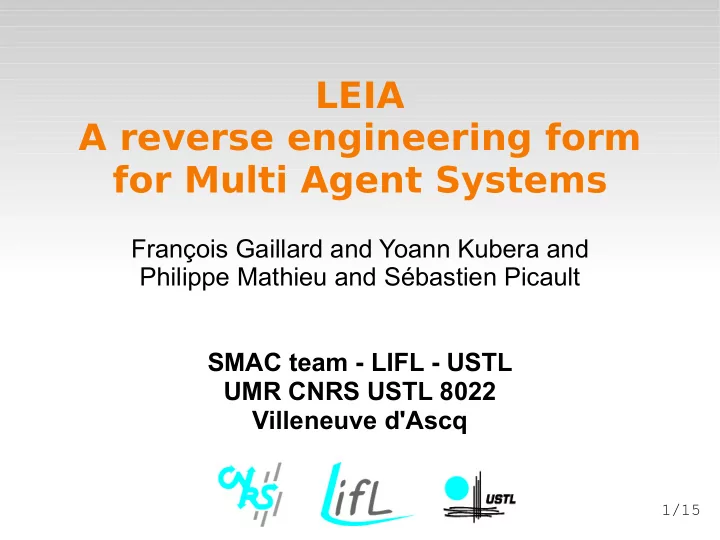

LEIA A reverse engineering form for Multi Agent Systems François Gaillard and Yoann Kubera and Philippe Mathieu and Sébastien Picault SMAC team - LIFL - USTL UMR CNRS USTL 8022 Villeneuve d'Ascq 1/15
Introduction What do we call reverse engineering for MAS ? What do we call reverse engineering for MAS ? Table of contents Table of contents I. SMAC team II. IODA III. LEIA IV. An interesting result from LEIA V. Conclusion 2/15
I – SMAC team software engineering for MAS Model of the behaviour of agents Implementation of the behaviour Evaluation of the behaviour of agents Design of experimentation platforms URL: www.lifl.fr/SMAC 3/15
II – IODA I nteraction O riented D esign of A gent simulation Methodology centered on Interactions Methodology centered on Interactions [Mathieu Routier 01] [Mathieu Routier 01] How does it work ? How does it work ? Separation between what an agent can do and how he will do it Separation between what an agent can do and how he will do it 4/15
II - IODA How can an interaction occur ? [Kubera 08] How can an interaction occur ? [Kubera 08] Declarative part Procedural part ➔ Interaction ➔ Order in the evaluation of the interactions ➔ Source/Target ➔ Selection process ➔ Distance Guard Interaction Matrix Interaction Matrix Distance Interactions guard Priority 5/15
III – LEIA: the exploration of simulations as a reverse engineering form Hypothesis Phenomenom Phenomenom forward engineering Model Model reverse engineering Implementation Implementation Results Why doing reverse engineering ? Understanding the model Understanding the model ➔ A brain stimulator [Pachet 07] A brain stimulator [Pachet 07] ➔ 6/15
III - LEIA LEIA lets you E xplore I nteractions for your A gents Problem Problem IODA model IODA model LEIA LEIA Analysis Analysis Implementation Implementation in JEDI in JEDI Reverse engineering on simulations Reverse engineering on simulations ➔ What we do: What we do: a simulation generator a simulation generator Simulations LEIA Ontology of Ontology of domain domain to be analysed 7/15
III - LEIA – Automatized building of model Domain ontology Domain ontology Agent families Interactions: Red Kill Blue Clone Green ... Yellow Fill with interactions We can do it thanks to IODA methodology ! We can do it thanks to IODA methodology ! 8/15
III - LEIA – Let's explore the simulations space Iterative construction of models by exploring the simulations space Iterative construction of models by exploring the simulations space Domain ontology LEIA LEIA Simplification Transformation Main model of model tools Interesting ... model 0 model n model ... Analysis simulation 0 simulation n 9/15
III - LEIA – our measurement tools Our aim: analysing a simulation during the runtime Our aim: Activity of the agents Number of modification of the environment The evolution of the population Mix and Cohesion Density of population An example: a battle simulation An example: a battle simulation Main points: Main points: ➔ Using the separation Interactions/Agents ➔ Working with any JEDI simulation and any ontology of domain ➔ Data from each families of agent and interactions 10/15
III - LEIA – Let's explore the simulations space Our aims: Our aims: ➔ Find new models ➔ Test the robustness of existing models ➔ Test an ontology of domain Our model transformation tools: Our model transformation tools: ➔ Test on the beginning number of agent ➔ Add/Remove random interactions ➔ Modification of the distance guard/priority ➔ Derivation of an interesting model into new models ➔ Play with several interaction matrices at a time 11/15
III - LEIA – Let's explore the simulations space 12/15
IV – An interesting result from LEIA Blue an infection model Red Green Yellow Excitable medium Excitable medium Cyclical cellular automaton Belousov-Zhabotinsky reaction [Griffeath 93] [Belousov 59, Zhabotinsky 50] 13/15
V – Conclusion → A simulation generator without any code generation → Made thanks to IODA methodology → The user is implied in the iterative process of exploration of the simulations space in order to create new models → guide lines to improve simulations following several metrics → Reverse engineering by analysis of simulations → Take place in a whole framework from the conception of interactions to their implementations using IODA, JEDI, JEDI Builder and now LEIA → Exploration of an ontology of domain with genetic algorithm Let's visit www.lifl.fr/SMAC/LEIA/ 14/15
Bibliography ➔ [Philippe Routier 01] Philippe Mathieu and Jean-Christophe Routier and Pascal Urro Un modèle de simulation agent basé sur les interactions ➔ [Pac07] F . Pachet. De la co-construction d’un langage homme-machine : quelques expériences en musique (JFSMA’2007) ➔ [Kubera 08] Sébastien Picault Yoann Kubera, Philippe Mathieu. Interaction-oriented agent simulations :From theory to implementation, ECAI 08 July 21-25 2008. ➔ [Kubera 08] Sébastien Picault Yoann Kubera, Philippe Mathieu. Une architecture orientée interactions. Revue d’Ingéniérie des Systèmes d’Information (ISI), 2008. ➔ [FGG93] R. Fisch, J. Gravner, and D. Griffeath. Metastability in the Greenberg-Hastings Model. March 1993. ➔ [Bel59] B. P . Belousov. A periodic reaction and its mechanism. In Compilation of Abstracts on Radiation Medicine, 1959. ➔ [Zha64] A. M. Zhabotinsky. Periodic processes of malonic acid oxidation in a liquid phase. In Biofizika, 1964. ➔ [Holland 75] Adaptation in natural and artificial systems ➔ [MonMarché Venturini 99] Imagine : a tool for generating HTML style sheets with an interactive genetic algorithm based on genes frequencies 15/15
Recommend
More recommend